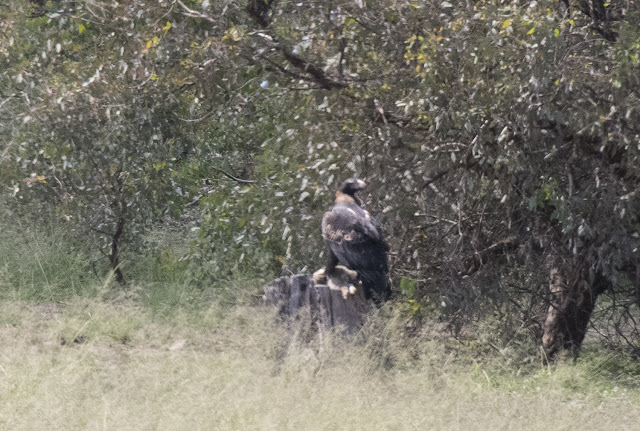Wedge-tailed Eagles and Red Fox
When out for an essential covid-19-era exercise walk yesterday I had a wonderful birding experience.
I heard a couple of ravens giving alarm calls which I recognised to be their call for eagle. I looked up but could not see anything, then from really high in the sky I saw a dot growing larger. It grew and grew and all the time I knew what it was, so just watched. Then a second bird materialised and both were diving, seemingly towards me. They dropped their feet and pulled their wings back. Then wham, the first bird, the adult male, struck at something in the long grass, 106m downhill from me. I measured the distance afterwards. He missed and a Red Fox jumped away, but before it could correct its balance the second bird, the female, slammed into it, or rather, as I identified later, a dead rabbit that the fox had been standing over. I never pulled my camera out during the dive and strike, so the first shots are as above, showing the eagle mantling over the rabbit as the fox stands beside it. These are not good photographs, all I could grab with a small lens fitted.

The male came back around and landed beside the female for a while, and the fox ran to cover below a sapling. All this time the ravens and magpies were giving the eagles a hard time.
The male flew up into the lower branches of nearby trees, and the female lifted the rabbit into the shade of a tree to begin eating it. The fox watched for a few minutes then slipped away.
The female dined on the rabbit for about 40 minutes. The male kept watch from the branches all that time, although he never came down to share the meal.
Meanwhile, their juvenile from last year's breeding season came over, calling, begging for a share of the food.
The youngster landed in a nearby tree, and kept giving occassional begging calls. Eventually, the female stopped eating and lifted the rabbit onto a stump.
Then she flew over and dropped the rabbit below the youngster, before landing in the same tree as it was perched in. The juvenile kept calling, as if asking the parent to deliver the food directly. That was not happening, so it dropped to the ground and ate the rest of the rabbit itself.
As can be seen by the wires in this shot, this all happend on the edge of suburbia in Canberra, where Wedge-talied Eagles are common.
She watched over the young bird while it ate. Perched on a roadside post.
When all was over, the two birds slipped out of the trees and headed away with an escort of ravens. I don't know where the adult male had gone meantime.
All that was left at the scene were a few fluffs of rabbit (right) and eagle (left) down.
And a covert feather from the eagle's wing.



















































